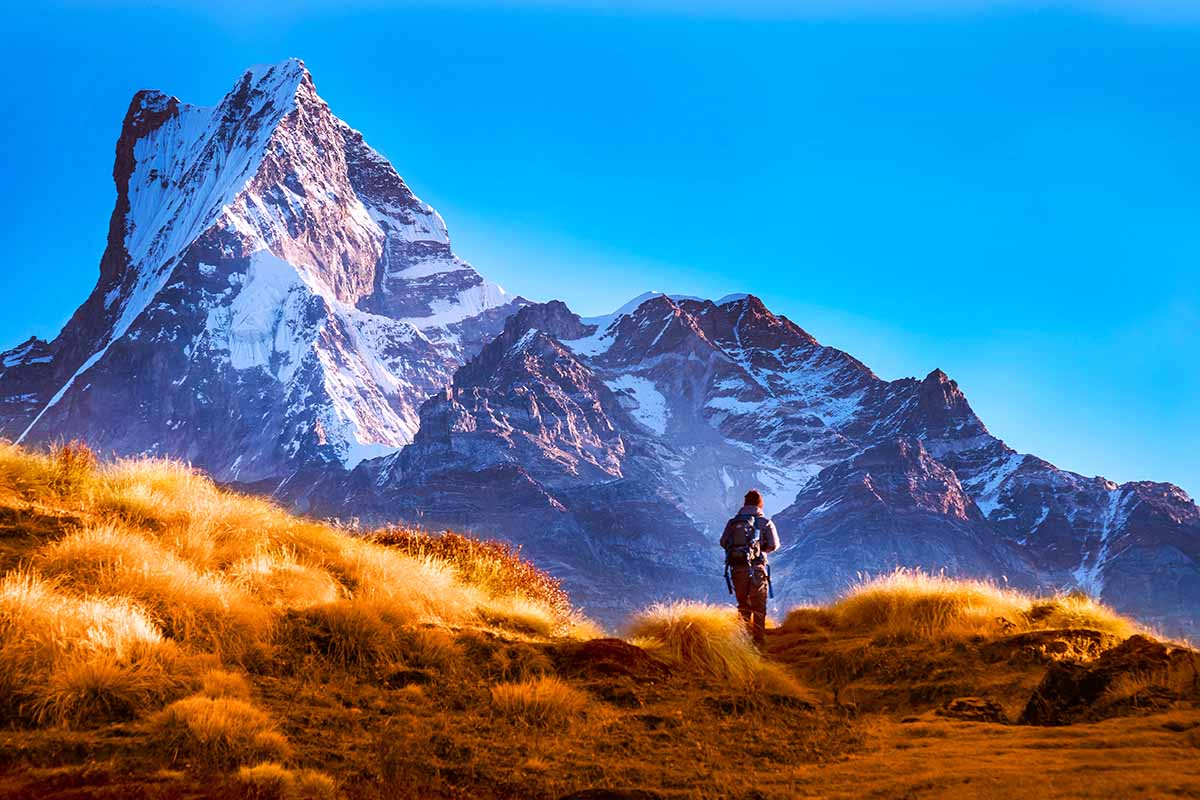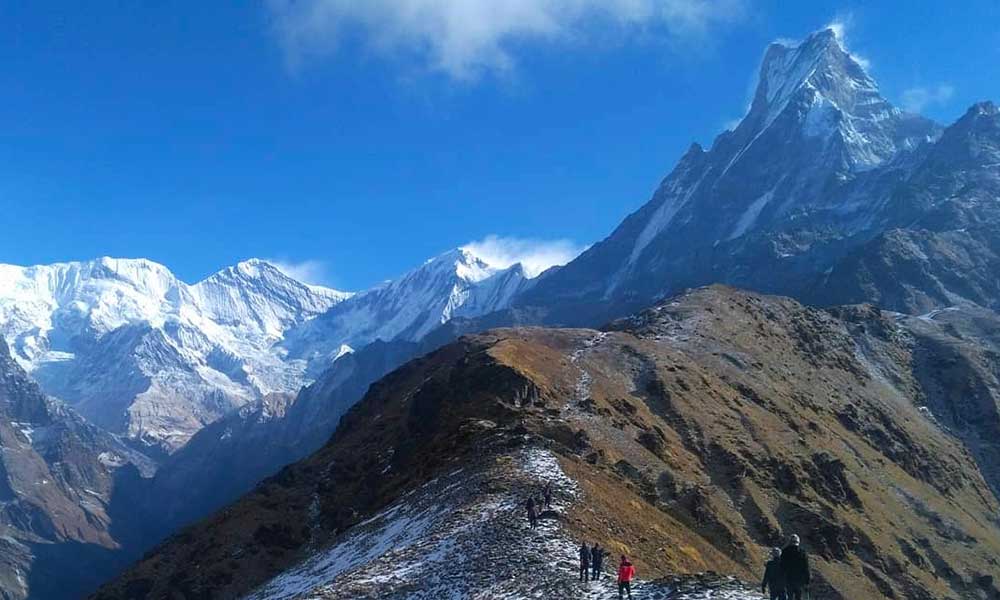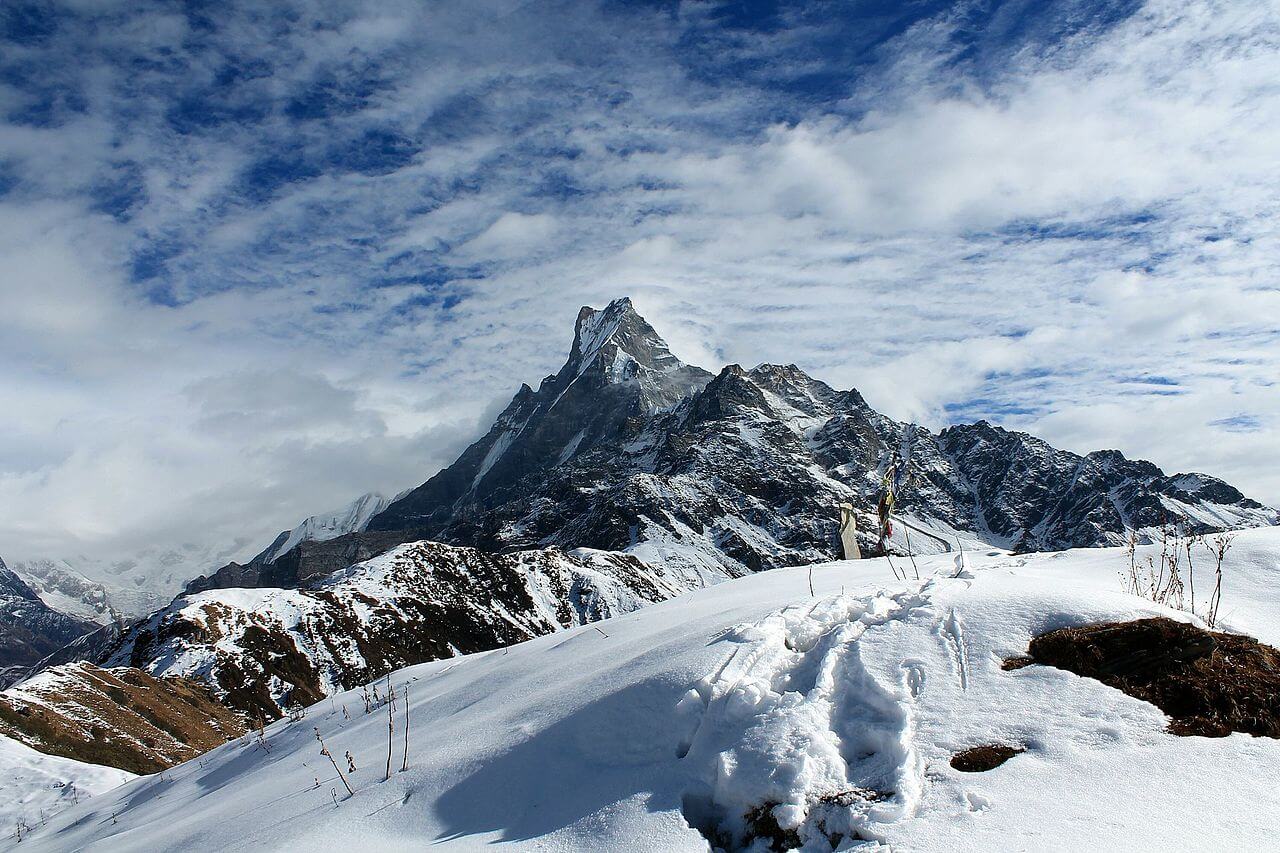- Day 01: Arrival in Kathmandu
- Day 02: Kathmandu to Pokhara
- Day 03: Drive to Kande and Trekking to Deurali (2232m)
- Day 04: Deurali to Forest Camp (2600m) about 5 hours walking
- Day 05: Forest Camp to Low Camp (2990) about 4 hours walking
- Day 06: Low Camp to High Camp (3550m) about 5 hours walking
- Day 07: Hike up to Upper Viewpoint (4,200m) & back to High Camp (3,590m)
- Day 08: High Camp to Sidding (1700m) about 6 hours walking
- Day 09: Siding Village to Lumre and drive back to Pokhara 2.5 hours walking and 1 hour drive
- Day 10: Pokhara to Kathmandu
- Day 11: Final Departure
Day 01: Arrival in Kathmandu
Meet at Tribhuwan International airport, Kathmandu and transferred to the hotel, after your freshness briefing program for your trekking, overnight at hotel.
Day 02: Kathmandu to Pokhara
In the morning, drive or fly to Pokhara, which takes about 30 minutes by flight and 6-7 hours by bus. Today you'll be free in Pokhara you'll visit yourself. Pokhara is gorgeous lake town that offers broad views of Mt. Machapuchre, Mt. Dhaulagiri, Mt Annapurna and Mt. Manaslu.
Day 03: Drive to Kande and Trekking to Deurali (2232m)
After breakfast at Pokhara hotel, drive to Kande which takes about 30 minutes by private vehicle. Then we continue our walking through local villages and beautiful forest to reach Deurali. Overnight in deurali
Day 04: Deurali to Forest Camp (2600m) about 5 hours walking
After breakfast, our day walk starts from Deurali to and ends at Forest Camp. First we walk through plain way and then we continue our walking through beautiful pine forest. We will take a packing lunch because there is not any hotel/restaurant on the way. Overnight in Forest Camp
Day 05: Forest Camp to Low Camp (2990) about 4 hours walking
The day walk is pleasant walk for us that we walking inside the forest. We will experience the thrill of walking in the wilderness rhododendron forest. The mountain views from low camp terrific. Overnight in Low Camp
Day 06: Low Camp to High Camp (3550m) about 5 hours walking
Today the trail goes out of forest, so we can enjoy the astonishing views Mount Annapurna South & Hinchuli Himal. We continue our walking to High camp for our overnight stay, from where we will have some incredible Himalayan views. Overnight in High Camp
Day 07: Hike up to Upper Viewpoint (4,200m) & back to High Camp (3,590m)
Early morning sunrise view and take a breakfast, then hike up to upper view point to get fantastic views Annapurna, Dhaulagiri and surrounding peaks of the Himalayas. After spending some time back to lodge, overnight in High Camp
Day 08: High Camp to Sidding (1700m) about 6 hours walking
Take a breakfast at High Camp and descend down towards Sidding village. We continue our walking through beautiful rhododendron forest to reach Low Camp. Take a lunch at Low Camp and we further walk to beautiful traditional Sidding village.
Day 09: Siding Village to Lumre and drive back to Pokhara 2.5 hours walking and 1 hour drive
Today is final day of our Mardi Himal trekking. We descend down to Lumre walking through the beautiful village of Tamang and Gurung. When we reach to Lumre, catch a vehicle and drive back to Pokhara. Overnight in Pokhara
Day 10: Pokhara to Kathmandu
Drive or fly to Kathmandu, which takes 30 minutes by flight and 6-7 hours by bus. Overnight at Kathmandu hotel
Day 11: Final Departure
Flight back to your home.

1. How difficult is the Mardi Himal Base Camp trek?
The Mardi Himal Base Camp trek is considered a moderate trek, suitable for trekkers with a reasonable level of fitness. While it involves some steep ascents and high-altitude hiking, it is shorter and less strenuous than other popular treks in Nepal, such as the Annapurna Circuit or Everest Base Camp. Trekkers should be prepared for varying weather conditions and be mindful of altitude sickness as they approach the higher elevations.
2. What is the best time to trek to Mardi Himal Base Camp?
The best time to trek to Mardi Himal Base Camp is during the spring (March to May) and autumn (September to November) seasons. During these periods, the weather is generally stable, and the skies are clear, offering stunning views of the surrounding peaks. Spring also brings blooming rhododendron forests, adding vibrant colors to the landscape. The winter months (December to February) can be cold and snowy, while the monsoon season (June to August) often brings heavy rain and slippery trails.
3. Do I need a guide or porter for the Mardi Himal trek?
While the Mardi Himal trek can be done independently, hiring a guide or porter is recommended, especially for those unfamiliar with the terrain or trekking in high altitudes. A guide can provide valuable insights into the local culture, ensure you stay on the correct path, and assist in case of emergencies. A porter can help carry your gear, making the trek less physically demanding and allowing you to enjoy the experience more fully.
4. What permits are required for the Mardi Himal Base Camp trek?
To trek to Mardi Himal Base Camp, you will need two permits: the Annapurna Conservation Area Permit (ACAP) and the Trekkers' Information Management System (TIMS) card. These permits can be obtained in Kathmandu or Pokhara before starting the trek. The ACAP helps fund conservation efforts in the region, while the TIMS card ensures the safety and security of trekkers by keeping a record of their journey.
Cost Inclusion
- Airport pick up and drop by private vehicle
- All Hotel/Accommodation in Kathmandu twin sharing on Bed and Breakfast
- All Hotel/Accommodation in Pokhara twin sharing on Bed and Breakfast
- All accommodation and meals during the trek (Breakfast, Lunch or Dinner).
- An experienced trekking guide including salary, insurance, flight, food and lodging
- Trekking porter
- All necessary paper works, trekking permits and TIMS card.
- A comprehensive medical kit
- All trekking equipment for trekking staff
- All government and local taxes
- All land transportation by private vehicle
Cost Exclusion
- Personal expenses
- Drinks, beverages, hot shower,
- Travel insurance
- Tips for Guide and porter (trekking staff)
.jpg)





.jpg)




